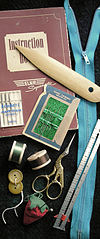- Bias (textile)
-
The bias (US) or cross-grain (UK) direction of a piece of woven fabric, usually referred to simply as "the bias" or "the cross-grain", is at 45 degrees to its warp and weft threads. Every piece of woven fabric has two biases, perpendicular to each other. Non-woven fabrics such as felt or interfacing do not have a bias.
Woven fabric is more elastic as well as more fluid in the bias direction, compared to the on-grain direction. This property facilitates garments and garment details that require extra elasticity, drapability or flexibility, such as bias-cut skirts and dresses, neckties, piping trims and decorations, bound seams, etc.
The "bias-cut" is a technique used by designers for cutting clothing to utilize the greater stretch in the bias or diagonal direction of the fabric, thereby causing it to accentuate body lines and curves and drape softly. For example, a full-skirted dress cut on the bias will hang more gracefully or a narrow dress will cling to the figure. Bias-cut garments were an important feature of the designs of Madeleine Vionnet in 1920s and 1930s and bias-cut styles are revived periodically. In the Middle Ages, before the development of knitting, hose were cut on the bias in order to make them fit better. The old spelling was byesse.[citation needed]
A garment made of woven fabric is said to be "cut on the bias" when the fabric's warp and weft threads are at 45 degrees to its major seam lines.
Note: The term "cross-grain" in the US refers to the direction perpendicular to the length-of-grain (selvage edges), not the diagonal.
See also
Categories:- Fabrics
- Sewing
Wikimedia Foundation. 2010.


